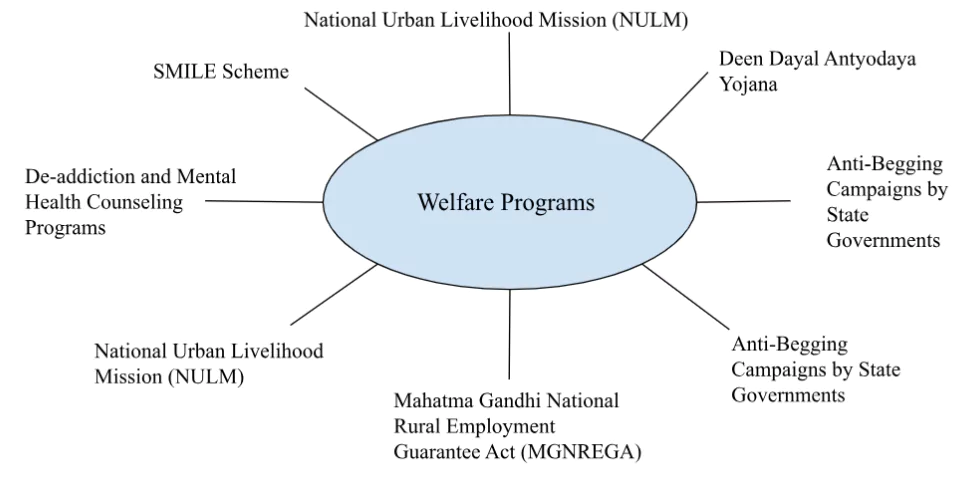Core Demand of the Question
- Highlight how begging continues to persist in India due to deep-rooted socio-economic vulnerabilities, despite numerous welfare programs
- Analyze the key factors contributing to this challenge
- Suggest policy measures to address this issue.
|
Answer
Begging, the public solicitation of alms, remains prevalent in India despite extensive welfare programs like MGNREGA and SMILE. Census 2011 indicates over 4.13 lakh individuals continue this practice, highlighting deep-seated socio-economic vulnerabilities like chronic poverty, low literacy, and limited employment opportunities that persist despite governmental intervention.
Enroll now for UPSC Online Course

Begging persists in India due to deep-rooted socio-economic vulnerabilities despite numerous welfare programs
- Ineffective implementation of welfare schemes: Welfare programs often fail due to weak execution, corruption, and lack of awareness among beneficiaries.
For example: Many beggars are unaware of schemes like SMILE, which offer shelter and livelihood support.
- Widespread poverty: Chronic poverty leaves individuals with no option but to beg for survival, especially in urban slums and rural areas.
For example: According to the 2011 Census, over 413,000 people were engaged in begging despite poverty alleviation schemes like MNREGA.
- Lack of vocational skills: Individuals engaged in begging often lack education and employable skills, restricting their ability to access formal jobs.
For example: Vocational training under the PMKVY scheme hasn’t reached marginalized groups like beggars effectively.
- Social stigma and exclusion: Vulnerable groups, including transgender persons and persons with disabilities, face societal neglect and exclusion from mainstream economic opportunities.
For example: Despite welfare schemes for transgender individuals, many are forced into begging at traffic signals due to lack of acceptance.
- Organized begging rackets: Criminal networks exploit vulnerable individuals by abducting and coercing them into begging, making it difficult to escape the cycle.
For example: In 2023, Delhi police rescued 50 children forced into begging by a trafficking racket.
Key factors contributing to the persistence of begging in India
- Inadequate data and identification: The lack of a centralized database prevents targeted interventions to rehabilitate those involved in begging.
For example: NHRC’s recommendation to create a national database using municipal records highlights the absence of reliable data on beggars.
- Limited access to education: Children engaged in begging miss out on formal education, perpetuating generational poverty and dependence on begging.
For example: Under the Right to Education Act, 2009, many children are still not enrolled due to lack of outreach efforts.
- Health and addiction issues: Substance abuse and untreated mental health problems keep individuals trapped in poverty and begging.
For example: Shelter homes under the SMILE scheme lack sufficient de-addiction and mental health counseling services, as noted in NHRC’s advisory.
- Urban migration and displacement: Rural-to-urban migration due to unemployment leads to overcrowding in cities, pushing migrants to resort to begging.
- Weak legal frameworks: Laws addressing begging are either punitive or inadequate to tackle organized rackets and rehabilitate individuals.
For example: The Bombay Prevention of Begging Act criminalizes beggars instead of addressing root causes, failing to curb forced begging networks.
Policy Measures to Address Begging in India
- Centralized Database and Identification System: Create a nationwide database of individuals engaged in begging, updated regularly, to enable targeted welfare interventions and monitor their rehabilitation.
For example: Municipal corporations can collaborate with NGOs to identify beggars, as recommended in NHRC’s advisory on using standardized survey formats.
- Strengthen Anti-Trafficking Laws: Introduce specific legal provisions to combat organized begging rackets, penalize perpetrators, and rehabilitate victims.
For example: Enacting laws to criminalize forced begging, as suggested by NHRC, would curb exploitation and trafficking networks.
- Expand Skill Development Programs: Provide skill-based vocational training in shelter homes to empower individuals to secure dignified employment or pursue self-employment opportunities.
For example: Shelter homes can partner with programs like PMKVY to train beggars in tailoring, carpentry, or other trades suited to their abilities.
- Accessible Healthcare and De-addiction Services: Set up mobile health units and mental health counseling services in shelter homes to address addiction, disabilities, and untreated illnesses.
For example: NHRC recommends integrating Ayushman Bharat benefits with shelter homes to ensure health coverage for rehabilitated individuals.
- Educational Access for Children: Enroll children involved in begging in schools under the Right to Education Act, ensuring they receive proper nutrition, uniforms, and financial support.
For example: Special awareness campaigns targeting parents of child beggars can boost school enrollments, especially in urban slums.
- Public Awareness and Almsgiving Reduction: Launch awareness campaigns to discourage the public from giving alms and promote donations to rehabilitation programs instead.
For example: Cities like Hyderabad have successfully implemented campaigns asking citizens to donate to government-run shelters rather than beggars.
Check Out UPSC CSE Books From PW Store
Empowering lives is the key to eradicating begging. Strengthening social safety nets, ensuring inclusive education, and promoting skill development can break the cycle of poverty. Strict enforcement of anti-begging laws, coupled with community-driven rehabilitation, will create a self-reliant India, where every individual contributes to the nation’s progress with dignity and purpose.
To get PDF version, Please click on "Print PDF" button.


🎯💎🏆 Great initiative of answer writing 🏆💎🎯
लोकः समस्ताः सुखिनो भवन्तु
( May all beings lead prosperous life across Globe 🌍 )